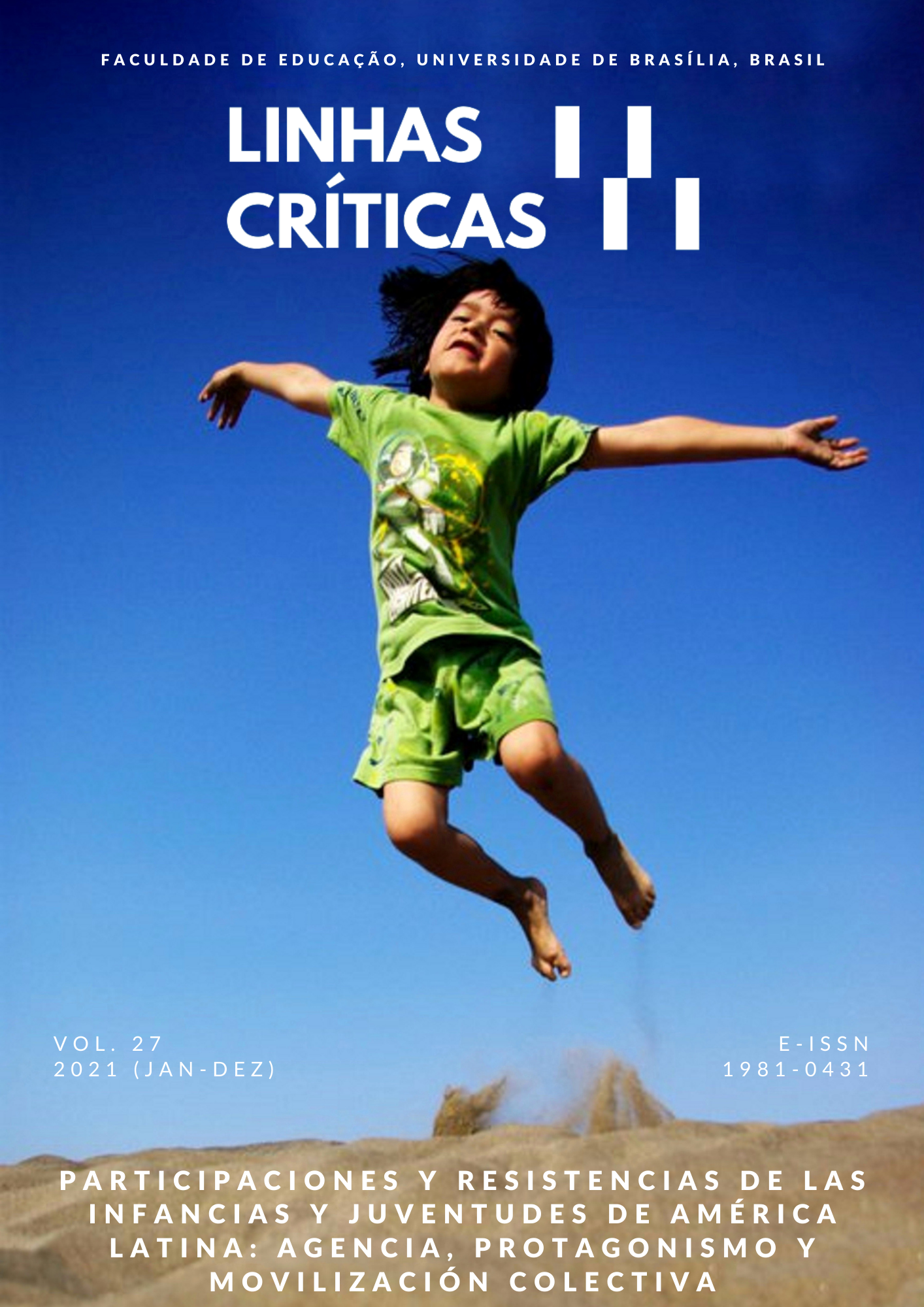Dance festival project
education through art
DOI:
https://doi.org/10.26512/lc.v27.2021.35022Keywords:
Dance Festival, Public school, Dance, Art-Education, Aesthetic educationAbstract
This research refers to the Dance Festival Project, at the Manoel Vicente Gomes Basic Education School, a public state school, in Santa Catarina. The objective of the investigation understands the role of a dance project in the development of students’ skills in the language and impact to the school community. The data were obtained through the analysis of the students reflective diaries of elementary and high school, as well as the practice report of the guiding teachers. Among the results, emphasizes the relevance of this project to the school community and the construction of a protagonist student and aware of the skills that can be developed through dance.
Downloads
References
Almeida, R. S., & Santos, T. P. B. (1997). A Dança: conteúdo escolar para a compreensão histórica da cultura corporal. Anais do IX Congresso Brasileiro de Ciências do Esporte – CONBRACE. Espírito Santo.
Baroni, V. (2015). Para além do unidimensional: Marcuse e a educação estética. Linhas Críticas, 21(46), pp. 784-800. https://doi.org/10.26512/lc.v21i46.4730
Berge, Y. (1986). Viver o seu corpo: por uma pedagogia do movimento (3. Ed.). Martins Fontes.
Brasil. (2017). Base Nacional Comum Curricular. Ministério da Educação. Secretaria de Educação Básica. http://basenacionalcomum.mec.gov.br/images/BNCC_EI_EF_110518_versaofinal_site.pdf
Colaço, S. F. (2015). A travessia do ser aluno para o ser professor: práticas de letramento pedagógico no PIBID.
Eidt, N. M., & Tuleski, S. C. (2010). Transtorno de déficit de atenção/hiperatividade e psicologia histórico-cultural. Cadernos de Pesquisa, 40(139), pp. 121-146. https://doi.org/10.1590/S0100-15742010000100007
Feijó, M. G. (1996). A Dança como conteúdo integrante da Educação Física escolar enquanto corporificação do mundo sensível. [Dissertação de mestrado, Universidade Federal de Santa Maria].
Fiamoncini, L. (2006). Dança na educação: a busca de elementos na arte e na estética (v. 6). Pensar a Prática, 6, pp. 59-72. https://doi.org/10.5216/rpp.v6i0.16055
Godoy, A. S. (1995). Pesquisa qualitativa: tipos fundamentais. Revista de Administração de Empresas, 35(3), 20-29. https://doi.org/10.1590/S0034-75901995000300004
Laban, R. (1990). Dança educativa moderna. Ícone.
Lacerda, T., & Gonçalves, E. (2009). Educação estética, dança e desporto na escola. Revista Portuguesa de Ciências do Desporto, 9(1), pp. 105-114. http://www.scielo.mec.pt/scielo.php?script=sci_arttext&pid=S1645-05232009000100010&lng=pt&tlng=pt
Lück, H. (2012). Perspectivas da avaliação institucional da escola. Vozes.
Marques, I. (2007). Dançando na escola. Cortes.
Marques, I. (2011). Notas sobre o corpo e o ensino de dança. Caderno Pedagógico, 8(1), pp. 31-36. http://www.univates.br/revistas/index.php/cadped/article/view/827/816
Oliveira, M. K. de. (2002). Vygotsky: aprendizado e desenvolvimento – um processo sócio-histórico (4 ed.). Scipione.
Pacheco, J. (2007). Caminhos para a inclusão: um guia para o aprimoramento da equipe escolar. Artmed.
Saraiva, M. C. (2009). Elementos para uma concepção do ensino de dança na escola: a perspectiva da educação estética. Revista Brasileira de Ciências do Esporte, vol. 30, n.3, pp. 157-171. http://rbce.cbce.org.br/index.php/RBCE/article/view/540/377
Sousa, N. C. P. de, Hunger, D. A. C. F., Caramaschi, S. (2014). O ensino da dança na escola na ótica dos professores de Educação Física e de Arte. Revista Brasileira De Educação Física E Esporte, 28(3), pp. 505-520. https://doi.org/10.1590/1807-55092014000300505
Souza, M. I. G. (2011). O ensino da dança na escola: técnica ou criatividade? Cadernos de Formação RBCE, (v. 2). n. 1, pp. 32-42. http://revista.cbce.org.br/index.php/cadernos/article/view/1206/612
Strazzacappa, M. (2006). Dança na educação: discutindo questões básicas e polêmicas. Pensar a Prática (v. 6). n.1, pp. 73-85. https://doi.org/10.5216/rpp.v6i0.55
Verderi, E. B. (2009). Dança na escola: uma abordagem pedagógica. Phorte.
Vigotski, L. S. (1989). Concrete Human Psychology. Soviet Psychology, v. 27, XXII, pp. 53-77.
Vigotski, L. S. (1998). Pensamento e linguagem (2. ed.). Martins Fontes.
Vigotski, L. S. (2004). A formação social da mente. Martins Fontes.
Additional Files
Published
How to Cite
Issue
Section
License
Copyright (c) 2021 Rozane Fermino, Camila Grimes, Flávio Booz, Carolina Cirilo, Jaqueline Magali Herartt, Natieli Herartt

This work is licensed under a Creative Commons Attribution 4.0 International License.
Authors who publish in this journal agree to the following terms:
-Authors maintains the copyright and grants the journal the right of first publication, the work being simultaneously licensed under the Creative Commons Attribution License which allows the sharing of the work with recognition of the authorship of the work and initial publication in this journal.
- Authors are authorized to enter into additional contracts separately, for non-exclusive distribution of the version of the work published in this journal (eg publish in institutional repository or as a book chapter), with acknowledgment of authorship and initial publication in this journal.
-Authorers are allowed and encouraged to publish and distribute their work online (eg in institutional repositories or on their personal page) at any point before or during the editorial process, as this can generate productive changes as well as increase the impact and the citation of published work (See The Effect of Free Access).



